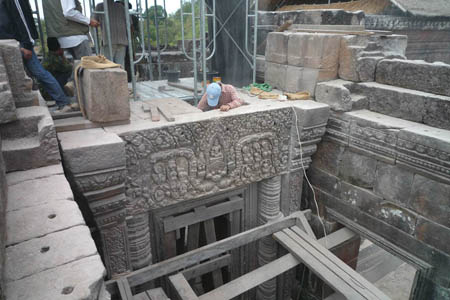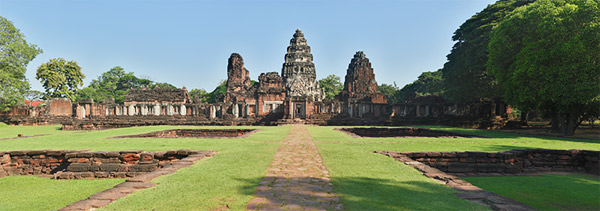In one of the very first issues of the BEFEO (Bulletin de l’École française d’Extrême-Orient), dated 1904, a long and famous article by Paul Pelliot, a founding member of EFEO, analyses the texts of Chinese geographers and pilgrims of the 8th century. From Xuanzhuang and Yijing, as well as from the Ancient History of the Tangs, he inferred that the kingdom which they call To-lo-po-ti (which would be transcribed today as Tuoluobodi) should have been located between Burma and Cambodia, that is, in the central plain of Siam, and that its original Sanskrit name would have been Dv?ravat?.
 Pierre Pichard at Vat Phu
Pierre Pichard at Vat Phu
His hypothesis was convincing enough to induce George Cœdès and Prince Damrong to group under the label of Dv?ravat? Style the first ancient artefacts, mostly sculptures and fragment of stucco decoration, which they collected from various places in central Thailand and more specifically around Nakhon Pathom, in the 1920s and 30s. At that time also, Cœdès and Prince Damrong could attribute this art to the Mon cultural context, on the evidence of a few and short inscriptions found in the same area.
After a first field investigation by George Cœdès at Phong Tuk in 1927, Pierre Dupont, was send in Thailand by EFEO in 1939 and 40, to undertake archaeological excavations on two sites near Nakhon Pathom, in co-operation with Luang Boribal Buribhand and the Fine Arts Department. The survey of these two brick buildings, though only partial since the excavations were interrupted by the 2nd World War, was published in several reports and articles, and was finally included, together with a general examination of all sculptures and fragments known at that date, in his doctoral thesis, L’archéologie mône de Dv?ravat?, posthumously published in 1959.
It is only in 1964, thus 60 years after Pelliot’s article, that this very name of Dv?ravat? was spectacularly confirmed by the publication by J.J. Boeles, in the Journal of the Siam Society, of two medals bearing an inscription in the name of the King of Dv?ravat?. They had in fact been found some twenty years before near Nakhon Pathom . Other similar medals have been unearthed more recently, providing the very material proof that Dv?ravat? existed in the early Siamese plain and not only in ancient Chinese travelogues
Since that time, several studies have been published on Dv?ravat? by various authors, amongst them Quaritch Wales in 1969, Piriya Krairiksh in 1974, and again in 1975 with his PhD thesis, and more recently by Robert Brown in 1996, Phasuk Intharavuth and Dhida Saraya in 1999, while Jean Boisselier undertook in the 1970s a series of archaeological excavations at U Thong. In the absence of dated inscriptions and chronological evidence, these works had to focus on art history, using comparative studies and evolution analysis. While Piriya Krairiksh could precise the chronological framework of the Phra Pathom Chedi and its stucco carvings, Robert Brown demonstrated the affinity in the numerous Wheels of the Law, a specific motive favoured by Dv?ravat? sculptors, with the pre-Angkorian art of Cambodia, thus showing a high degree of cultural relationship in South-East Asia before the 10th century.
As more and more sites and artefacts closely linked with the Dv?ravat? art were found in several other sites, such as Si Thep and U Thong, as well as in the North-East of Thailand, scholars were inclined to think of Dv?ravat? as a large, centralised kingdom spread out on a large part of present day Thailand. However, given the notable regional and local differences, there is today a more general agreement to consider that the region was inhabited by people of predominantly but not exclusively Môn culture and language, distributed in a network of distinct settlements under the authority of local chiefs, amongst which contacts may have been intense without inducing a formally unified state. For others Dv?ravat? should be used more restrictively, just as a convenient term to define an historical period, roughly from 6th to 11th century AD.
More evidence is certainly needed to get a better understanding of this important period which witnessed the arrival of Buddhism in Siam. As Robert Brown points out: is it possible to study history of art when we have no history? If French scholars were instrumental in starting research on Dv?ravat?, the onus is now in the hands of Thai archaeologists and historians, together with scholars from other nationalities since it is more and more evident that international co-operation is a powerful tool for deepening our knowledge. There is certainly more opportunities for such studies, as shown for instance by the recent excavations in Muang Champasi, jointly organised by the Silpakorn University and former members of EFEO now attached to the Paris Universities, or by the joint archaeological prospections of the Fine Arts Department and EFEO carried out by Daniel Perret around Pattani, in the South of Thailand.
During their long and close relationship, Prince Damrong and George Cœdès initiated or modernised several Thai institutions which are still now the backbone of archaeological and historical researches: the National Museum, the National Library and Archives, the Department of Fine Arts. George Cœdès was also the President of the Siam Society from 1926 to 1930. The epigraphic studies of George Cœdès, on Sukhothai inscriptions in particular, were instrumental to provide a first framework to the Thai history, even if some of his interpretations were later revised by Prasert na Nagara and Alexander Griswold. Here again, the works of Thai epigraphists and historians like Professors Uraisi Varasarin or Charnvit Kasetsiri have now given a new impetus to these studies.
As it is well known, the EFEO was actively involved in the conservation of Angkor monuments from the beginning of the century. Although preliminary investigation was undertaken as soon as 1901 in the Bayon Temple for recording purposes, the systematic clearing of monuments begun in 1907, when the French Government officially entrusted the conservation of Angkor monuments to EFEO.
 Thailand’s Phimai Temple
Thailand’s Phimai Temple
The process began on major temples like Angkor Vat, Bayon, Baphuon or Bakheng, and was progressively extended to the royal city of Angkor Thom and to other monuments. The first task, to cut down the trees which had been growing on the monuments themselves and to remove the accumulated earth, loose stones and debris, was not an easy one since they were intricately mixed with the stonework. It was immediately clear that the larger trees could not be removed without at least some partial repairs and refitting of the structures. Concurrently, records and inventories of monuments were systematically produced by Lunet de Lajonquière, Claeys and Parmentier, in Cambodia as well as in parts of Siam.
The consolidation process, firstly limited to temporary measures like shoring and propping the unstable parts, took a new impetus in the 1930s with the introduction of the anastylosis method, consisting on dismantling the buildings, totally or partially, and rebuilding them on improved foundations, using the original materials. This method, well adapted to stone structures built without mortar, was first developed in Greece, and then experimented in South-East Asia by the Dutch archaeologists working in Indonesia. It was adopted in Angkor by Henri Marchal, and progressively improved by architects and archaeologists such as Jean Trouvé and Bernard Philippe Groslier.
In 1963, Bernard Philippe Groslier presented a technical report on the possible reconstruction of the central shrine of Phimai, a large khmer temple of the 11th century, half ruined, located in the north-eastern Thai province of Nakhon Rajasima. The conservation works was undertaken in 1964 and completed in 1970 by the Fine Arts Department, under the direction of Prince Yachai Chittrabongse, with the technical assistance of B.P. Groslier and P. Pichard, together with a complete architectural survey of the monument. A second temple, Phanom Rung, was undertaken in 1972, with the same French co-operation. Now, 30 years after the works, the central shrine of these two temples is in sound and stable condition, and no new weakness has been detected in their foundations nor in their structure.
These successful operations gave enough assurance to the Fine arts Department to complete by itself the restoration of other Khmer temples in the North-East, including the beautiful site of Muang Tam. Recently the conservation of Phanom Wan, another Thai-French project, was initiated as a training centre in order to upgrade the capacity of the Fine Arts Department’s staff. It is a delicate project, because the condition of the monument is worse than in the other cases, the quality of the sandstone is poorer, and because several successive alterations and rebuildings have been done on the temple in ancient time.
The network that EFEO has developed in Asia during this century has been instrumental in promoting an active exchange of ideas and experiences amongst scholars and students. For instance, Thai architects and archaeologists could study the architecture of South India in the EFEO centre of Pondicherry, where they meet their colleagues from Burma and Nepal. Conversely, Khmer and Burmese trainees where invited on the site of Phanom Wan to work for a while with their Thai colleagues. We believe strongly that these kind of international workshops is extremely stimulating and should be promoted systematically. Another instance is the participation of EFEO members in multilateral projects initiated by SPAFA or by Unesco in Angkor or in Vat Phu.
In all these cases, French scholars from EFEO worked in close co-operation with Thai archaeologists and historians, and shared with them experience and knowledge. In fact, some of the most successful achievements resulted from life-long personal friendships between Thai and French scholars, such as George Cœdès and Prince Damrong, or Jean Boisselier and Prince Subhadradis Diskul. If at the beginning the French side could initiate methods or processes which were new in this country, their Thai counterparts were fast to adopt and master them, and today any co-operation programme is on a totally reciprocal basis. These links between departments, institutions and universities of both countries are regularly strengthened by exchange of experts and students, and our sincere hope is to develop and reinforce them in this new century.